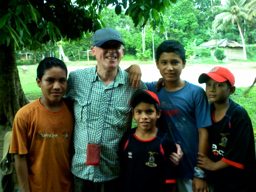Jesus in the Jungle
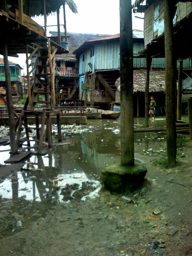 Let me tell you about my day yesterday. We were up bright and early because we had a lot of things that we wanted the group to experience.
Let me tell you about my day yesterday. We were up bright and early because we had a lot of things that we wanted the group to experience.
Peru is certainly a land of contrasts. The previous morning we had all witnessed the majestic splendour of the high snow-capped mountain known as Hauscran as we flew back from Hauraz in the small plane.
 Today we travelled to Peurto Belen and witnessed what must be one of the saddest places on earth. What a contrast between the beauty of natural world and the sheer ugliness of a contaminated environment. I've been trying to work out which is the worst: the sheer hell of living in a place like the Atacama desert where over a million people try to scratch out a living on the parched dusty dry land where there is very little water and work is scarce; or to live in Belen surrounded by contaminated water that is dangerous to drink.
Today we travelled to Peurto Belen and witnessed what must be one of the saddest places on earth. What a contrast between the beauty of natural world and the sheer ugliness of a contaminated environment. I've been trying to work out which is the worst: the sheer hell of living in a place like the Atacama desert where over a million people try to scratch out a living on the parched dusty dry land where there is very little water and work is scarce; or to live in Belen surrounded by contaminated water that is dangerous to drink.
For me it's an academic question.For the people living in these places there is no choice, it is equally academic. However it impinges on their dignity as a human being. Surely in this world no one should live like this? Yet millions who live in the world's shanty towns do.
Clean water is a major factor in bringing about a changed environment in both these places. It is important that we as a Trust don't forget about the underlying causes of much of the poverty and disease.
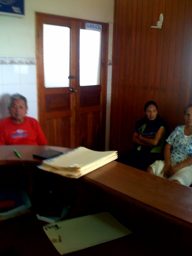 We made our way to the medical centre in Belen erected by a generous donation from Lloyds TSB Foundation Scotland. Here in this clinic up to 40 or 50 people are treated daily. The centre seeks to work on close harmony with the other two governor sponsored clinics.
We made our way to the medical centre in Belen erected by a generous donation from Lloyds TSB Foundation Scotland. Here in this clinic up to 40 or 50 people are treated daily. The centre seeks to work on close harmony with the other two governor sponsored clinics.
Belen is a shanty town built on the sewer that flows out of the city of Iquitos. It has two parts to it Upper Belen and Lower Belen. Our clinic is in the heart of lower Belen. At this time of the year the water rises in the lower part of the settlement. The people move around on little dugout canoes. It all looks very picturesque until you look closer and realise the water all around the houses is untreated sewage. About 66,000 people live in this community 26,000 of them are children. The death rate is high. You don't see many older people, life expectancy is not very high.
It is from this shanty town built on a sewer that Union Biblica in partnership with the Vine Trust run a free health care service seeking to help over 100,000 people in this part of Amazonia.
Today as we visit there is a medical team from various parts of the UK who have arrived to help augment the work that is being pioneered by a group of dedicated Peruvian medics. This team under the leadership of Vanessa Bone (a Peruvian who is married to Martin Bone who hails from the UK) is seeking to develop realistic strategies to help improve the health of those who live in this area.
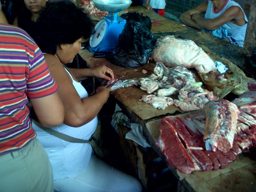
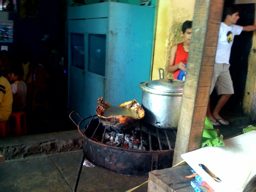 After visiting the centre it was back on the canoes again and we headed to the market to get an opportunity to see how many earn a living. Have a look at these pictures. The woman making the turtle soup was using the shell of the turtle as the pot to boil the soup. Another woman was eating a bowl of soup with the claw of the turtle on the plate to add flavour -- I think!
After visiting the centre it was back on the canoes again and we headed to the market to get an opportunity to see how many earn a living. Have a look at these pictures. The woman making the turtle soup was using the shell of the turtle as the pot to boil the soup. Another woman was eating a bowl of soup with the claw of the turtle on the plate to add flavour -- I think!
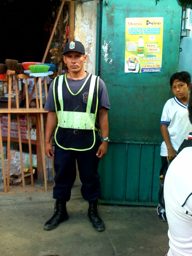 I took this picture of the policeman who escorted us through the market. I guess he was seeking to do a bit of crime prevention. It was on to the bus for a visit to the Casa los Tigres. This is a centre which seeks to feed and educate children and thus prevent them from being put on the streets by a mother. We heard a few stories which I will relate on the blog over the next few weeks.
I took this picture of the policeman who escorted us through the market. I guess he was seeking to do a bit of crime prevention. It was on to the bus for a visit to the Casa los Tigres. This is a centre which seeks to feed and educate children and thus prevent them from being put on the streets by a mother. We heard a few stories which I will relate on the blog over the next few weeks.
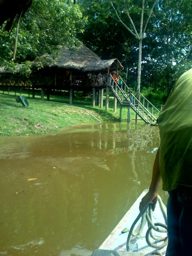 From the Casa Los Tigres we headed off to pick up a wooden thatched boat go make our journey to Puerto Allegria to meet up with the 30 children who have now made this jungle oasis home.
From the Casa Los Tigres we headed off to pick up a wooden thatched boat go make our journey to Puerto Allegria to meet up with the 30 children who have now made this jungle oasis home.
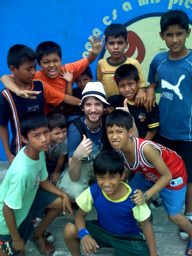 Once again take note of the contrasts. Here in this peaceful settle 30 little boys have been given a shelter a home and parents to look after them.
Once again take note of the contrasts. Here in this peaceful settle 30 little boys have been given a shelter a home and parents to look after them.
As I come to the end of this my sixth trip to Peru I am amazed at the work that has been accomplished. There is still much more to be done but what has been achieved acts as an incentive to us all that we can achieve even greater things if we continue to live and grow in the Vine. 